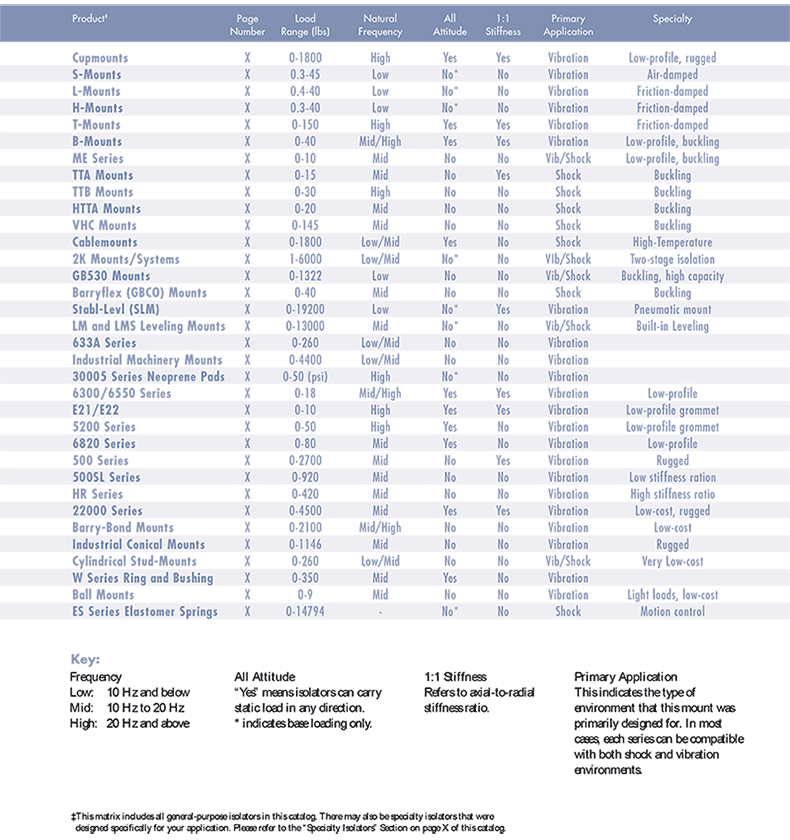Mechanical vibration and shock are present in varying degrees in virtually all locations where equipment and people function. The adverse effect of these disturbances can range from negligible to catastrophic depending on the severity of the disturbance and the sensitivity of the equipment.
INTRODUCTION
In one extreme, the vibration environment may consist of low-level seismic disturbances present everywhere on earth, which present operating problems to highly sensitive items such as delicate optical equipment. When other disturbances are superimposed on the seismic disturbances, a wide range of precision equipment is adversely affected.
These other disturbances are caused by such things as vehicular and foot traffic, passing trains, air conditioning systems, and nearby rotating and reciprocating machinery. They cause resolution problems in electron microscopes, disturb other optical systems, cause surface finish problems on precision grinders and jig borers, and hamper delicate work on microcircuitry.
Another concept is the detrimental effect of vibrating internal components of certain equipment such as motors, blowers, and fans in computers or similar systems. These components transmit noise and vibration to the surrounding structure resulting in fatigue, reduced reliability, and a “noisy” product.
When compared to stationary applications, vehicular installations subject equipment to much more severe shock and vibration. Vibration from a propulsion engine is present in air, sea and road vehicles as well as shock and vibration effects from the media in which they travel.
Such common phenomena as air turbulence and rough roads impart severe dynamic transients to the vehicles traveling on them. In addition to rough seas, military ships are also subjected to very severe mechanical shock when they encounter near-miss air and underwater explosions in combat.
Vibration-control techniques in the form of shock and vibration isolators have been devised to provide dynamic protection to all types of equipment.
In discussing vibration protection, it is useful to identify the three basic elements of dynamic systems:
- The equipment (component, machine motor, instrument, part, etc. ..);
- The support structure (floor, baseplate, concrete foundation, etc. ..); and
- The resilient member referred to as an isolator or mount (rubber pad, air column, spring, etc.) which is interposed between the equipment and the support structure.
If the equipment is the source of the vibration and/or shock, the purpose of the isolator is to reduce the force transmitted from the equipment to the support structure. The direction of force transmission is from the equipment to the support structure. This is illustrated in Figure 1, where M represents the mass of a motor which is the vibrating source, and K, which is located between the motor and the support structure, represents the isolator.
If the support structure is the source of the vibration and/or shock, the purpose of the isolator is to reduce the dynamic disturbance transmitted from the support structure to the equipment. The direction of motion transmission is from the support structure to the equipment. This occurs, for instance, in protecting delicate measuring instruments from vibrating floors. This condition is illustrated in Figure 2, where M represents the mass of a delicate measuring instrument which is protected from vibrating floor by an isolator signified as K.
In either case, the principle of isolation is the same. The isolator, being a resilient element, stores the incoming energy at a time interval which affords a reduction of the disturbance to the equipment or support structure. The purpose of this Design Guide is to aid the design engineer in selecting the proper isolator to reduce the amount of vibration and/or shock that is transmitted to or from equipment.

DEFINITIONS
Although a vibration isolator will provide some degree of shock isolation, and vice versa, the principles of isolation are different, and shock and vibration requirements should be analyzed separately. In practical situations, the most potentially troublesome environment, whether it be vibration or shock, generally dictates the design of the isolator. In other applications, where both are potentially troublesome, a compromise solution is possible.
Before a selection of a vibration and/or shock isolator can be made, the engineer should have a basic understanding of the following definitions, symbols, and terms:
Vibration: A magnitude (force, displacement, or acceleration) which oscillates about some specified reference where the magnitude of the force, displacement, or acceleration is alternately smaller and greater than the reference. Vibration is commonly expressed in terms of frequency (cycles per second or Hz) and amplitude, which is the magnitude of the force, displacement, or acceleration. The relationship of these terms is illustrated in Figure 3.
Frequency: Frequency may be defined as the number of complete cycles of oscillations which occur per unit of time.





Displacement: Displacement is a vector quantity that specifies the change of the position of a body or particle and is usually measured from the mean position or equilibrium position. In general it can be represented by a translation or rotation vector or both. (See Figure 3)


Damping: Damping is the phenomenon by which energy is dissipated in a vibratory system. Three types of damping generally encountered are: coulomb, hysteresis and viscous.
Coulomb Damping: If the damping force in a vibratory system is constant and independent of the position or velocity of the system, the system is said to have coulomb or dry friction damping.
Hysteresis (Inherent) Damping: Damping which results from the molecular structure of a material when that material is subjected to motion is referred to as hysteresis damping. Elastomers are good examples of materials which possess this type of damping.
Viscous Damping: If any particle in a vibrating body encounters a force which has a magnitude proportional to the magnitude of the velocity of the particle in a direction opposite to the direction of the velocity of the particle, the particle is said to be viscously damped. This is the easiest type of damping to model mathematically. All of the equations in this text are based on use of a viscous damping coefficient. Although most isolators do not use viscous damping, equivalent viscous damping usually yields excellent results when modeling systems.
Damping Coefficient: Damping for a material is expressed by its damping coefficient.

Transmissibility: Defined as the ratio of the dynamic output to the dynamic input.
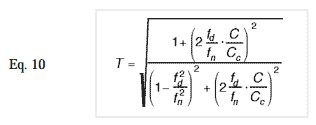


Shock Pulse: Shock pulse is a primary disturbance characterized by a rise and decay of acceleration from a constant value in a very short period of time. Shock pulses are normally displayed graphically as acceleration vs. time curves. See Figure 11 for examples of typical curves.
Shock Transmission: Shock transmitted to the object subjected to the shock. This can be calculated with the following equation:

The associated dynamic linear deflection of an isolator under shock can be determined by the use of the following equation:

DESIGN CONSIDERATIONS
Vertical Vibration: In the general introduction of this Guide, it was pointed out that vibration and shock can have gross detrimental effects on the performance and reliability of a particular product. The vibration which a unit transmits to a supporting structure or the vibration which a unit feels when it is being excited by a vibrating structure can be reduced or attenuated by an isolator if properly selected. Referring to the following discussion of how an isolator functions, the design example section of this Guide contains problem solutions which use the equations and graphs presented in this section.

Isolation is attained primarily by maintaining the proper relationship between the disturbing frequency and the system’s natural frequency. The characteristics of the isolator include its natural frequency, or more properly, the natural frequency of the system consisting of isolator and mounted equipment. In general, a system has a natural frequency for each degree of freedom; the single-degree-of-freedom system illustrated in Figure 4 thus has one natural frequency. The expression for the damped natural frequency of the system illustrated in Figure 4, expressed in cycles per second, is:

In most circumstances the value of the damping coefficient is relatively small. The influence of damping on the natural frequency may then be neglected. Setting the damping coefficient C equal to zero, the system becomes an undamped single-degree-of-freedom system, and the undamped natural frequency given by:

The concept of static deflection often is used to define the characteristics of an isolator. Static deflection is the deflection of the isolator under the static or deadweight load of the mounted equipment. Referring to Equation 2 and substituting in/sec2, , the following expression is obtained for natural frequency in terms of static deflection:

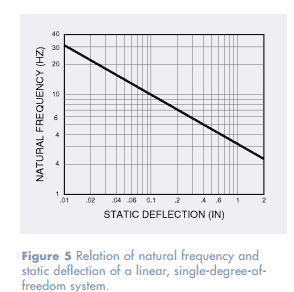
Metallic springs generally meet this latter requirement, but many organic materials used in isolators do not. The dynamic modulus of elasticity of these materials is higher than the static modulus; the natural frequency of the isolator is thus somewhat greater than that calculated on the basis of static deflection alone.
Dynamic stiffness may be obtained indirectly by determining the natural frequency when the isolator is vibrated with a known load and calculating the dynamic stiffness from Equation 2. The various organic materials have certain peculiarities with respect to dynamic stiffness which will be discussed later in connection with the specific materials.
Effectiveness of isolators in reducing vibration is indicated by the transmissibility of the system. Figure 6 illustrates a typical transmissibility curve for an equipment of weight W supported on an isolator with stiffness K and damping coefficient C which is subjected to a vibration disturbance of frequency fd. When the system is excited at its natural frequency, the system will be in resonance and the disturbance forces will be amplified rather than reduced.Therefore, it is very desirable to select the proper isolator so that its natural frequency will be excited as little as possible in service and will not coincide with any critical frequencies of the equipment.
Referring to Figure 6, it can be seen that when the ratio of the disturbing frequency fd over the natural frequency fn is less than or 1.4, the transmissibility is greater than 1, or the equipment experiences amplification of the input. Simply expressed, when:
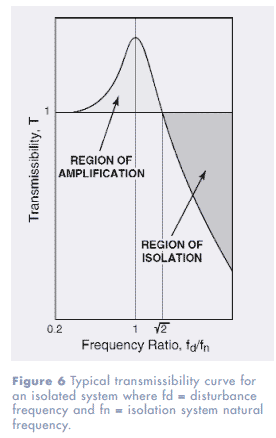
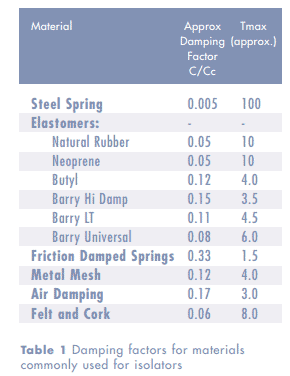
Damping: The majority of isolators possess damping in varying degrees. A convenient reference illustrating damping factor C/Cc for various materials is shown in Table 1. Damping is advantageous when the mounted system is operating at or near its natural frequency because it helps to reduce transmissibility. For example, consider an internal combustion engine mounted on steel springs which possess very little damping (see Table 1). Upon start up of the engine and as the engine RPM increases, the disturbing frequency of the engine will at some point correspond with the natural frequency of the spring-mass system. With light damping the buildup of forces from the engine to the support will be very large; that is, transmissibility will be very high. If the idle RPM of the engine falls in the range of the natural frequency of the spring-mass system, serious damage may result to the engine or to the support chassis. If, on the other hand, the designer selects an elastomeric isolator which possesses a higher degree of damping, amplification at resonance would be much less.
The relationship between a highly damped and a lightly damped system is illustrated in Figure 8. This figure shows that as damping is increased, isolation efficiency is somewhat reduced in the isolation region. While high values of damping cause significant reduction of transmissibility at resonance, its effect in the isolation region is only a small increase transmissibility.
A family of curves which relate fn, fd, transmissibility and damping are shown in Figure 8. This family of curves was derived by use of Equation 10.

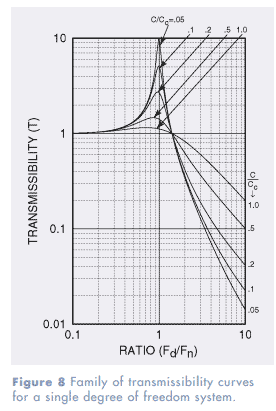
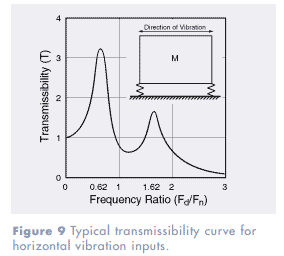
Horizontal Vibration: When an isolation system is excited horizontally, two natural frequencies result if the center of gravity of the unit is not in line with the elastic center of the isolators. A typical transmissibility curve illustrating this horizontal vibration output is illustrated in Figure 9. The two natural frequencies which are involved include a lower mode wherein the equipment rocks about a point well below the elastic center of the isolators and a higher mode where the equipment oscillates about a point in the vicinity of the center of gravity. Two other natural frequencies will occur if the equipment is rotated 90 degrees in the horizontal plane with respect to the exciting force.
Figure 10 can be used to determine the approximate frequencies of these modes as a function of spring stiffness and equipment dimensions. These curves assume that the equipment is solid, of uniform mass, and that the isolators are attached at the extreme corners. Under horizontal excitation the equipment may be made to translate only by lining up the center of gravity of the equipment with the elastic center of the isolators instead of installing the isolators at the bottom corners of the equipment. In this case, Figure 10 may be applied by letting H/W = 0, which results in only one mode of vibration, that of translation. A second mode can only be excited by torsional excitation.
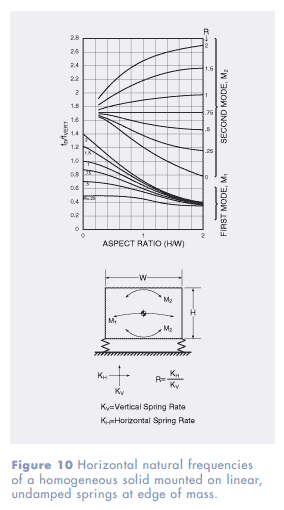
Structure-Borne Noise: The demand on equipment today is to maximize its output which generally requires faster operation and more complex mechanical motions. As a result, noise is sometimes generated. High frequency disturbances are excited because the moving components within the equipment impose vibratory inputs to the internal structures. These vibrations are amplified and structureborne noise is encountered. Complete equipments bolted to their support foundations also cause similar noisy conditions.
An effective and low cost means of alleviating structureborne noise problems is to physically separate the solid structures and interpose a resilient material between them. In this manner a mechanical attachment is provided but the resilient media prevents the vibration forces from being transmitted nd structure-borne noise is substantially reduced.
Elastomeric materials are generally best suited for structure-borne noise reduction. They exhibit the desirable characteristics of shape flexibility and inherent damping to avoid spring-like response which might produce violent resonances at critical frequencies. They afford high frequency isolation. Many isolators suitable for attenuation of structureborne noise problems are available from All-State Industries, Inc..
Shock: Shock is normally classified as a transient phenomenon, while a typical vibration input is classified as a steady-state phenomenon. A shock input pulse is normally described by its peak amplitude A expressed in g’s, by its duration t normally expressed in milliseconds, and its overall shape, which can take such forms as half-sine, triangular, (initial peak sawtooth, symmetrical and terminal peak sawtooth), versed sine, rectangular, and the form most likely to occur in nature, a more or less random shaped complex waveform force and acceleration impulse as shown in Figure 11. Since there are many types of shock pulses encountered in nature, there are many types of shock tests specified for testing a piece of equipment. The different shock tests are normally associated with the environment that the equipment will encounter during its lifetime. Equipment installed in aircraft is normally tested on a free-fall shock machine which will generate either a half-sine or terminal peak sawtooth form. A typical test is an 11-millisecond half-sine waveform with a peak acceleration of 15 g’s. For components in some areas of missiles where large shock pulses will be felt due to explosive separation of stages, a 6-millisecond sawtooth at 100 g’s may be specified. If a piece of equipment is going on board a Navy vessel, the normal test will be the hammer blow specified in MIL-S-901, which exhibits a velocity shock of approximately 120 in./sec. Shipping containers are normally tested by dropping the container on a concrete floor, or by suspending it by some suitable support mechanism and letting it swing against a concrete abutment. Other tests pertaining to shipment are edge and corner drops from various drop heights. All of these tests mentioned attempt to simulate the shock pulse which will be encountered in the normal environment of the equipment. These are generally called out by the specific contractual requirements either in a specification or in a work requirement.
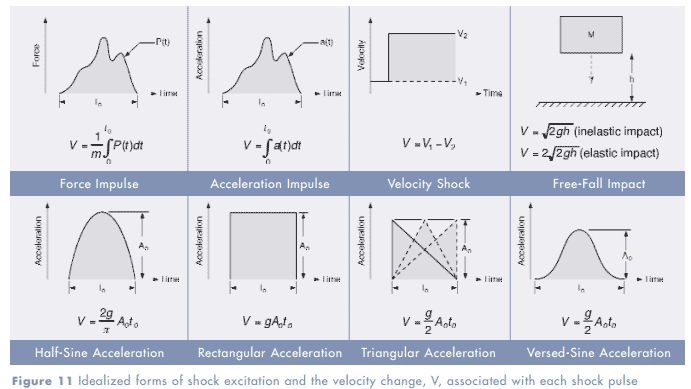
The most common procedure for predicting shock isolation is a mathematical approach utilizing equations in Figure 11, for determining the velocity, and Equation 13, for calculating transmitted accelerations.
Another means is through the use of shock transmissibility curves. Shock transmissibility curves are not included in this Guide, but are included in a technical paper published by Barry Controls titled Passive Shock Isolation. Please call 817-453-110 for a copy of this paper.
These two methods are valid for solving shock problems provided that the shock pulse is thoroughly defined, and that the isolation system responds in its linear region.
Nonlinear Isolators: The preceding discussion of vibration and shock isolation presumes that the isolator is linear, the force-deflection curve for the isolator is a straight line. This simplified analysis is entirely adequate for many purposes. In the isolation of steady-state vibration, displacement amplitude is usually small, and nonlinearity of the isolator tends to be unimportant except where deflection resulting from the static load is relatively great. In the isolation of shock, nonlinearity tends to be more important because large deflections prevail. The degree of isolation may then be substantially affected by the ability, or lack thereof, of the isolator to accommodate the required deflection.
In many applications of shock isolation, sufficient space is not available to allow for full travel of a linear isolator. Therefore, a nonlinear isolator is necessary. There are two types of isolators that can be designed to help solve the problem of insufficient space.
The first solution is to make an isolator that gets stiffer as deflection increases. This will limit the amount of motion, but will increase the G level imparted on the equipment. The second is to use an isolator that is stiff at small deflection, but gets softer at higher deflections. This is referred to as a buckling isolator, and is shown in Figure 12. This allows the isolator to store more energy in the same amount of deflection. (A shock isolator is basically an energy storage device; it stores high g-level, short-duration shock and releases them as low g-level, longer-duration shocks.)
ISOLATORS AND MATERIALS
Isolators are made from a wide variety of resilient media having diverse characteristics. Each type of isolator has characteristic properties and is particularly suited to certain specialized applications. To make the best use of available isolators, the designer should understand the basic properties of each type. He should also be familiar with the requirements for isolators for various types of equipment, as indicated in the preceding discussions. Keep in mind that not all isolators can be manufactured out of any material.
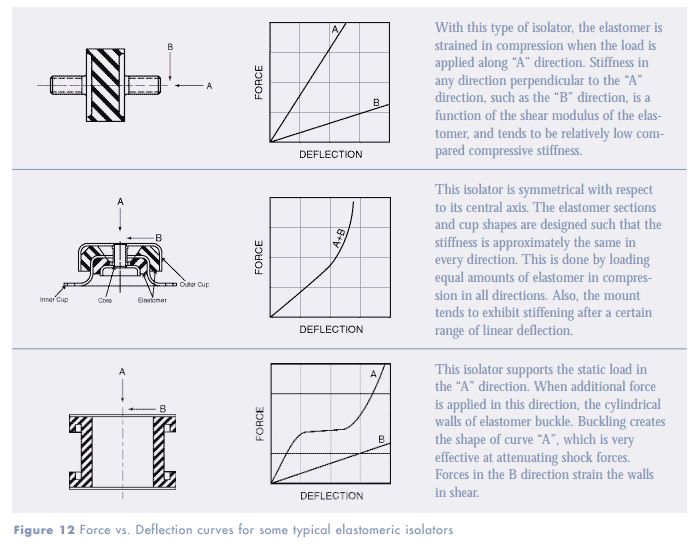
Most elastomeric isolators cannot be constantly subjected to large strains. An isolator with a large static deflection may give satisfactory performance temporarily but it tends to drift or creep excessively over a relatively short period of time. Opinions on maximum permissible static strain vary widely, but it may be taken as a conservative limitation that elastomers should not be continuously strained more than 10 to 15% in compression, nor more than 25 to 50% in shear. These rules of thumb are often used to determine the maximum load capacity of a given isolator.
In spite of the limitations of elastomeric materials used in isolators, the overall advantages far outweigh the disadvantages and make elastomers the most highly desirable type of resilient media for isolators.
With this type of isolator, the elastomer is strained in compression when the load is applied along “A” direction. Stiffness in any direction perpendicular to the “A” direction, such as the “B” direction, is a function of the shear modulus of the elastomer, and tends to be relatively low compared compressive stiffness.
Springs: Metal springs can be used as vibration isolators. In some instances, these types of isolators work well. Frequently, the lack of damping in these type of isolators forces them to experience extremely violent resonances conditions (see “Damping” section and Figure 8).
Combination Spring-Friction Damper: To overcome the disadvantages of little or no damping in coil springs, friction dampers can be designed in parallel with the load-carrying spring. These types of isolators are widely used in practice. An example of this is illustrated in Figure 13.
In this construction, along the vertical axis a plastic damper slides along the walls of a cup housing, and the normal force is provided by a radial damper spring. For horizontal damping, a central metal core which is directly attached on its top side to the equipment bears on the damper on its bottom side. The normal force is provided by the weight of the equipment, and damping results from the sliding during horizontal excitations. Transmissibility values of about 2 are exhibited by using this type of spring/damper combination.
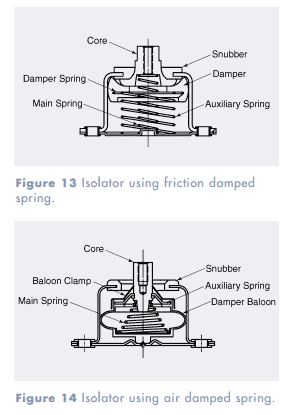
Combination Springs with Air Damping: Another method of adding damping to a spring is by use of an air chamber with an orifice for metering the air flow. An example of this type of isolator is illustrated in Figure 14. In this construction the load-carrying spring is located within the confines of an elastomeric damping balloon. The air chamber is formed by closing the balloon with a cap which contains an orifice or the force flow metering. Under dynamic excitations the air in the balloon passes through a predetermined sized orifice by which damping is closely controlled. Transmissibilities generally under 4 result with this type of design.
Air-damped springs have some specific advantages over seemingly similar friction damped designs with respect to isolating low-level inputs. Air damping, a form of viscous damping, causes the damping forces to be reduced if the input levels are reduced.
With friction damping, the friction force is constant. In practice, this means that the damping ratio is effectively increased with the input levels are decreased. Referring to Figure 8, one can see increasing the damping ratio decreases the level of isolation. In summary, air damped isolators are best suited for isolating low-level vibrations, while friction damped isolators are usually ideal for higher-level vibrations.
Combination Springs with Wire Mesh Damping: For applications where all meal isolators are desired because of temperature extremes or other environmental factors, damping can be added to a load carrying spring by use of metal mesh inserts Figure 15 illustrates this concept.
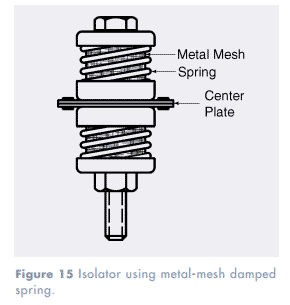
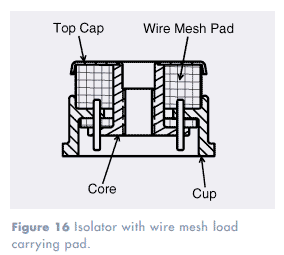
Wire mesh cushions are sometimes used as isolators without the addition of a spring in parallel. Although transmissibilities of such an isolator range in the region of 4, an isolator so designed has the disadvantage of creep or high compression set. Once the metal pads take a compression set their performance under dynamic conditions is difficult to predict. An example of this type isolator is illustrated in Figure 16.
Pneumatic Systems: This type of isolator utilizes the principle of supporting the static load on an air column. It is particularly useful where low fn systems are required; that is, 0.5 to 3 Hz region. An air spring enables the system to have a “zero” static deflection under load. This is particularly noteworthy since a conventional spring system would need to deflect a magnitude of 3.3 feet to acquire a 0.5 Hz natural frequency and 1.1 in. for a 3 Hz natural frequency. Pneumatic isolators can use a method of damping called sprung damping. This allows the isolator to have very high damping at resonance, but very low damping in the isolation region. A Barry pneumatic isolator which follows the laws of relaxation of sprung damping offers the benefits of very low T at resonance (generally 1.5) and yet offer a high degree of isolation in the high-frequency regions by acting as an undamped spring.
All-State Industries, Inc. also offers a complete line of actively controlled pneumatic isolators. To request information on our Active and Pneumatic Vibration Solutions, call 817-453-110.
Miscellaneous Types of Isolators: Other materials sometimes are used for vibration and shock isolators. Wool felt is often used for mounting entire machines but is seldom designed as a component part of a machine. A similar situation exists with regard to cork. Another material in the same category is neoprene impregnated fabric. The manufacturers of spun glass have also suggested the use of this material for the isolation of vibration. All of these materials appear to have characteristic advantages for particular installation. However, the ability of these materials to isolate vibration and particularly shock is difficult to predict, and the dynamic properties of these materials are not well documented in the technical literature.
Little difficulty is encountered in the design of isolators using elastomeric materials or metal springs. The performance characteristics of these materials are very predictable under dynamic conditions.
STEP-BY-STEP ISOLATOR SELECTION
Step 1: Determine the frequency of the disturbing vibration, often called the disturbing frequency, fd. There are a number of ways to determine the disturbing frequency. For rotating equipment, the disturbing frequency is usually equal to the rotational speed of the equipment, expressed in revolutions per minute (RPM) or cycles per minute (CPM). If the speed is specified in RPM or CPM, it must be converted to cycles per second (Hz) by dividing by 60.
For other types of equipment, disturbing frequencies must be specified by the manufacturer or measured. Environmental vibrations can also be measured, or are sometimes specified in military or commercial specifications or test reports.
There could be more than one disturbing frequency. In this case, one should first focus on the lowest frequency. If the lowest frequency is isolated, then all of the other higher frequencies will also be isolated.
The most important thing to remember about vibration isolation is that without knowing the frequency of the disturbing vibration, no analytical isolation predictions can be made. In many of these cases, All-State Industries, Inc. can recommend solutions that have worked well in similar past applications. Please contact our Applications Engineering Department at 817-453-110 if you need help or advice on your application.
Step 2: Determine the minimum isolator natural frequency, fn, that will provide isolation. This natural frequency can be calculated by using the following equation:

At this point, there will be many isolators that can be removed from the list of possible selections. Our catalog clearly states the natural frequency range of each isolator family in the main information block on the first page of each family. If any of the information is missing or unclear, please contact All-State Industries, Inc. Applications Engineering at 817-453-110.
Step 3: Determine what isolator natural frequency will provide the desired level of isolation. Step 2 has provided a quick way to determine which mounts provide isolation, but does not provide any information on the level of isolation that will be achieved. Equation 11 can be used to calculate transmissibility:


Step 4: Select the appropriate isolator for your application. Step 3 should reduce the list of possible isolators considerably, but there still may be more than one isolator that “qualifies.” One way to determine which is best suited is to look under the “Applications” heading on the first page of each isolator family. If your application is not in this list, it does not necessarily mean that the isolator can’t be used, but there may be a better choice.
The selection can also be narrowed down by looking at the environmental and dimensional data sections for each candidate isolator. Is the temperature range appropriate? Can the isolator fit in the required space? Is the mount capable of supporting a load in the necessary direction? These are typical questions than can be used to make a final selection.
If there is still more than one isolator that fits your application, or if you cannot find one that meets all of your requirements, please contact our Applications Engineering department at 817-453-110. We have expert engineers available to help make selections and answer questions about our products.
DESIGN EXAMPLES
This section deals with the selection and application of vibration and shock isolators. For the proper selections of isolators, it is desirable to obtain, where possible, pertinent information relating to the equipment, input and output requirements, and the general environment. Examples of the type of information or data required are:
Relating to the equipment:
-
- Weight.
-
- Dimensions.
-
- CG location.
-
- Number and location of isolators.
-
- Available space for isolators.
- Fragility level of the equipment.
Relating to the dynamic inputs and outputs:
-
- Level of vibration.
-
- Level of shock.
- Space limitations.
Relating to general environment:
-
- Temperature.
-
- Humidity.
-
- Salt spray.
-
- Corrosive atmosphere.
- Altitude.
All of the above information is not always readily available nor is it always completely required in some applications. This will be further clarified in the following problem examples.
Example 1 – Vertical Vibration: A metal tumbling drum directly driven by a 1080 RPM motor is causing vibration disturbance to the floor on which it is mounted the drum, motor, and support base weighs 400 pounds. There are 4 mounting points for the isolators.The required isolation is 80%.
- Determine fn of isolators required by using mathematical methods.
- Determine static deflection of isolators by using (a) mathematical methods and (b) the static deflection vs. natural frequency curve in Figure 5.
- Determine damping factor C/Cc to limit transmissibility at resonance to 10 by using (a) mathematical methods and (b) the transmissibility curve in Figure 8.
- Determine the resilient media which could be used in the isolator selected to provide the C/Cc required.
- Determine the proper isolator to use for this application.
SOLUTION:
Known facts 
Isolation required = 80%
i.e. transmissibility = 0.20
Disturbing frequency, fd = 1080 RPM
1. Using Equation 16, page 63:

2a. To find static deflection using mathematical approach use Equation 4, page 53:

2b. To find static deflection using static deflection-natural frequency curve Figure 5, page 56. The intersection of fn of 7.35 Hz and the solid diagonal line yields a Ds of approximately 0.18 inches.
3a. To find C/Cc for a transmissibility of 10 by mathematical approach use Equation 12, page 54. Solving for C/Cc:

3b. To find C/Cc for a T of 10 by use of the transmissibility curve Figure 8, page 57. This curve shows that for a transmissibility of 10, C/Cc = 0.05.
4a. To find the correct resilient media which exhibits a C/Cc = 0.05 refer to Table 1, page 57. It can be seen that natural rubber or neoprene would be the proper selection.
5a. An isolator which best fits the above solved parameters is Barry Part No. 633A-100. Refer to the product information on pages 116-118 of this catalog to confirm that this product meets all of the above needs.
Example 2 – Vertical and Horizontal Vibration: An electronic transmitter which weighs 100 pounds, and has a height of 15″, a width of 20″ and a length of 30″ is to be mounted in a ground vehicle which imparts both vertical and horizontal vibratory inputs to the equipment. Since rough terrain is to be encountered a captive isolator is required. Four mounting points, one at each corner, are provided. It has been determined that the first critical frequency of the equipment is such thatan isolator with a 25 Hz vertical natural frequency would be satisfactory. Select an appropriate isolator and determine the approximate horizontal rocking modes in the direction of the short axis of the equipment which would be excited.
Solution:
- For vertical natural frequency: Load per isolator = 100/4 = 25 lb. Referring to a Barry isolator series designed for the rigors of vehicular applications, the 5200 series is suitable. From the load rating table in the product information section (18-30 pounds capacity for vehicular applications) would handle the 25 pound load.Using the load vs. natural frequency plots on page 192, the intersection of the 5220 curve for the 25 pounds load yields an fn of 24 Hz.
- For horizontal rocking modes: The dynamic stiffness ratio of horizontal to vertical = 0.6 for the 5200 series. Referring to Figure 10, page 58 and assuming that mass is homogeneous and isolators are at extreme corners, the following is found:
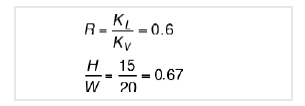
From the curves in Figure 10, page 58, the ratios of fn/fVERT for first mode M1 is 0.7 and for second mode, M2, is 1.7.fn, 1st mode = 24 X 0.7 = 16.9 Hz
fn, 2nd mode = 24 X 1.7 = 40.8 HzIt is seen that this procedure lends a ready solution to determining the horizontal rocking modes based on the assumptions made. This solution is not exact but is generally satisfactory for practical purposes.
Example 3 – Shock: An electronic equipment is to be subjected to a 15G, 11 millisecond half-sine shock input. The equipment is mounted on a 10 Hz natural frequency isolation system. Determine maximum shock transmission and isolator deflection.
Solution:
- The equation for shock velocity change for a half-sine pulse is:

where:
Ao=15G
to=0.011 sec
g=386 in/sec2
using Equation 13, page 55, the maximum shock transmission is:

using equation 14, page 55, the isolator deflection required to attenuate this shock:

ISOLATOR PROPERTIES MATRIX
